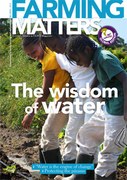Pablo Tittonell makes the case that we can learn from nature about how to restore the soil’s capacity to capture and store water. Moreover, he argues, this agroecological solution brings many additional benefits for society.
The need to increase water availability for agriculture through the construction of dams, channels or costly irrigation systems has dominated the agenda of development agencies and donors for over 40 years. In the Sahel, for instance, water has always been assumed to be the most severe limiting factor to agricultural productivity, yet in-depth studies from the end of the 1990s already showed that most crops in the region are mainly limited by a lack of nutrients and not by water. But a huge dam is prestigious, visible, and often pays off in political terms.
I do not mean to imply that irrigation systems are not necessary. Indeed most of our civilisations, institutions, governance and political systems emerged in ancient irrigation areas. But there is not enough water to increase our irrigation footprint much further.
What are the alternatives? The amount of water stored in the top 60 cm of one hectare of healthy soil can be enough to fill an Olympic swimming pool. Why not work on increasing water capture and storage in the soil, instead of relying exclusively on irrigation?
Back to the Sahel. The local savannah vegetation growing on extremely sandy soils and receiving 300 to 400 mm of rain per year can produce up to 20 tonnes of biomass annually. A cropping field with millet and cowpeas under the same conditions produces only one tenth of that on average. A soil under natural vegetation can infiltrate 443 mm of rain water in one hour; it can literally ‘swallow’ a storm, while a cultivated soil can only infiltrate, at max, 30 mm per hour.
This has at least two implications. First, that nature has found a way to produce large amounts of biomass in extremely dry conditions; we should learn from this and use it when designing farming systems for dry areas. For example, keeping trees or shrubs in the system can contribute to reducing soil surface temperature – and thus evaporation – dramatically. Second, those cropping systems that produce only one tenth of the biomass compared to the savannah vegetation, will also contribute only one tenth of the carbon to the soil, leading to less soil organic matter and therefore much less capacity to capture and store water.
So there is a lot to gain from restoring the soil’s capacity to capture and store water. And, as with many agroecological solutions, there are also other benefits associated with better soil physical conditions. Amongst others, increased biological diversity, more efficient nutrient cycling, erosion control and even indeed, better use of irrigation water when available.
Pablo Tittonell
Pablo Tittonell is coordinator of the National Program on Natural Resources and Environment of the Instituto Nacional de Tecnología Agropecuaria (INTA) in Argentina and Professor of the Farming Systems Ecology group at Wageningen University and Research Centre, the Netherlands. He is a board member of the African Conservation Tillage network and member of the Latin American Scientific Society on Agroecology (SOCLA). He is our regular columnist for 2015.

